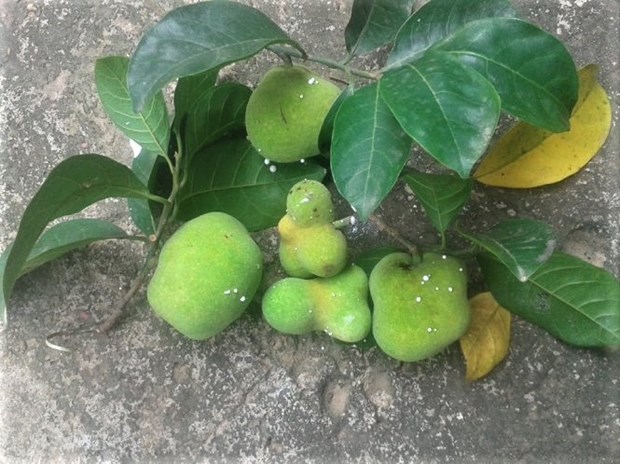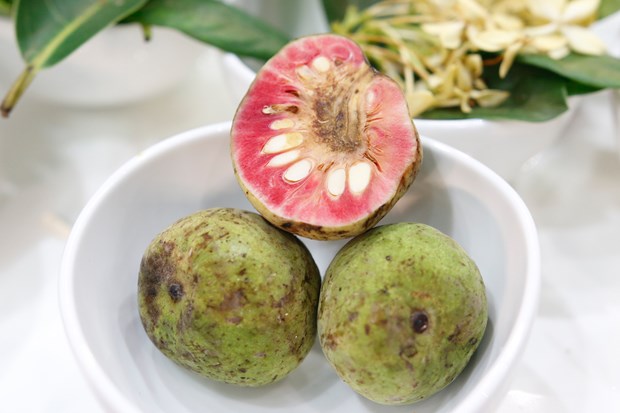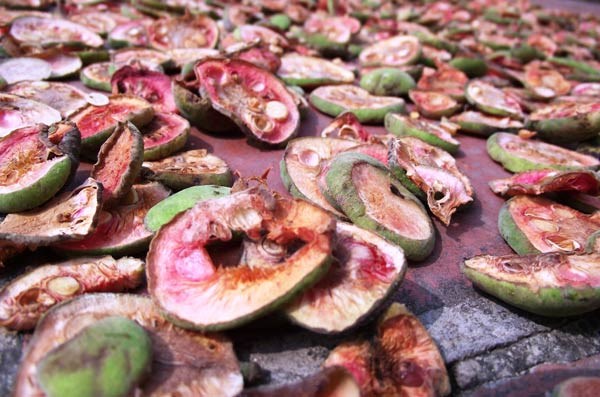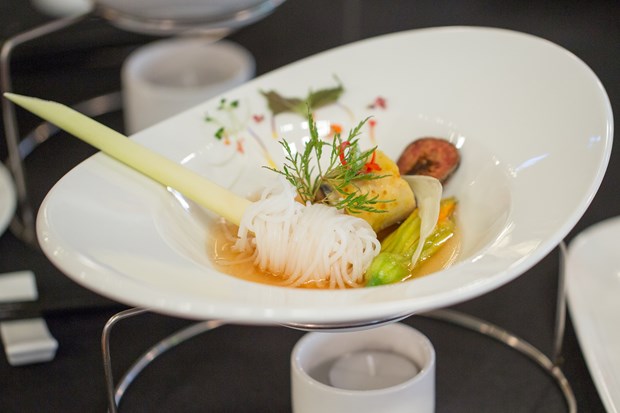The spices that raising up gastronomical stream inside us are so plentiful. The mellow and unforgettable strong taste of them, however, just can be counted on fingers. The fruits of A. Tonkinensis swaying in late summer, are among them.

Fresh leaves and fruits of A. Tonkinenesis. Photo by Hoang Han.
The
trees of A. Tonkinesis grow mostly in highland provinces of the North as: Lao
Cai, Bac Can, Lai Chau… They can also be found in Hue, Quang Nam, Quang Ngai…
Long ago, since “betel begins the conversation”, its roots were important to
our people so they usually add A. Tonkinensis roots in a betel quid to be
chewed together for.
Many
Vietnamese traditional medicine documents mentioned that its leaves and roots
could be used to treat backache or Metrorrhagia. Meanwhile, extraction of A.
Tonkinensis ripe fruits with sour flavor and balancing effect can be used as
appetizer for better digestion and delicious meal.
However,
the prominent difference between medicines of the North and the South, as well
as the dishes and medicines made from A. Tonkinensis are quite opposite. The
first group expresses acrid smell that easy to get bored. The latter group, on
the other hand, raises flavorful tangy scent that so stimulating and appealing
in the senses of customers. Each style has its own charm that irresistible!

Vertical cut of an A. Tonkinensis fruit. Photo by Trung Dung.
In
the sizzling heat of tropical summer, a bowl of A. Tonkinensis soup made with
white-oar fish from flowing streams and thorny bamboo shoot would be better
than great! Vo Hieu Trung, photojournalism – a connoisseur in food, living in
Hanoi old quarter, but really love travelling far for photo hunting in the
cat-ear limestone of the Northwest – said with delightful eyes.
Tran
Cao Duyen, an editor of Song Tra magazine, from Sa Huynh, Quang Ngai,
enthusiastically said: his family usually saves the dried ripe pieces of A.
Tonkinensis in earthenware pots for using within a year. From the end of spring
in his homeland, young A. Tonkinensis fruits have been growing in the enormous
and higher than human’s sights branches. Till the end of summer, the fruits
grow as big as the local eggs with lovely yellow-orange skin. The fruits have
been raising their tanginess!

Pinky pieces of dried A. Tonkinensis. Photo by Nhu Minh.
“A. Tonkinensis soup
made with small fresh water fish seasoned with Sa Huynh coarse salt, added
slightly chopped green bird’s eyes chili pepper. Turn off heat. Add some
tamarind to increase the charming gentle tangy flavour. So great!” Duyen breathlessly described,
tantalizing listeners about the food.
In
another recipe, pieces of dried A. Tonkinensis are put on top of small tiny
crabs (varunidae, varunid crab) with full of eggs inside their shelves, all
cooked in an earthenware. The varunid crabs turn to override the fresh green
leaves of piper lolot at the bottom of the pot. Below, the flame quickly heats
up the pot. Above, two to three tablespoons of pork fat filled with some cloves
of shallot are melting down the food. Reduce heat, put the lid on, and simmer.
Finally, season with salt and fish sauce to finish. “You know, it’s
mouthwatering delicious!”, said Ton That Lang, living in O Mon District, Can
Tho.

Gà tre (Vietnamese bantam) made with A. Tonkinensis, a dish to be introduced in The Golden Spoon Awards.
As
mentioned, the trees and fruits of A. Tonkinensis grow naturally. They have
been flexibly utilized in traditional food and medicines by our elders through
generations. That is so uncountable!
But,
how to “take advantage of” such precious spice the best, increasing its
nutrition as well as the unforgettable taste.
Doctor
Nguyen Phuc Ung Vien, a traditional doctor of Nguyen Dynasty, had proposed a
good but complicated recipe. “A. Tonkinensis fruits combined with wild Giac
(leaves and fruits) to make soup, or to be poached with fishes, stir-fried,
mixed as local salads… bring out the greatest dishes ever!”, he strongly
insisted.
Usage of A.
Tonkinensis fruits
Following
Nguyen’s Dynasty documents of medical food, fruits of A. Tonkinensis help quenching
thirst, improving eyesight, detoxing liver and kidneys. Especially, it can be
used to detox cells, and bladder for a cleanse urinary system. However, they
need to preliminary prepared in the right way before cooking:
1.
Dipping into salted water then taking out, leaving until dry from 1-5 minutes.
2.
Dipping into homemade vinegar, taking out and leaving dry as (1).
3.
Dipping into alcohol and following as above.
4.
Pan-frying glutinous rice until hot, putting Giac leaves and drying until
withered a bit.
These
should be followed to eliminate toxicity, helping medical food promoted its
effectiveness as mentioned.
Pharmacist Le Kim
Phung analyze pharmaceutical values and cautions of A. Tonkinensis
Artocarpus
tonkinensis A. Chev ex Gagnep, Moraceae family, is the large woody plant with wide branches.
Its leaves are similar with fig leaves. The fruits are round shape with convex
and concave, yellow skin when matured, and pinky flesh with sweet and sour
flavor. People usually get the fruits for eating then drying for later use. The
trees mostly grow in Ha Giang, Thanh Hoa, Nghe An.
Young
A. Tonkinensis fruits contain lots of tannin, which taste a bit tart but do
have stable effects and hemostasis. When matured, the fruits taste sweet and
sour containing vitamin C, sugar, organic acid; can be used as appetizer – help
better digestion and delicious meal. Its roots only contain tannin, which taste
really tart. People usually chew A. Tonkinensis roots together with betel quid
(betel and areca), or use them to treat diarrhea and infected wounds. Some
researches state that the leaves of A. Tonkinensis have high content of
flavonoid with strong antioxidant effect. The researchers are currently
proceeded.
Ripe
fruits of A. Tonkinensis can be served raw, made sour soup, or dried for later
use making soup.
Folk
medicine usually uses raw fruits or their juice to reduce body inner heat
symptoms and sore throat, appetite loss.
Its
roots are used to treat rheumatism, backache, and sore knees with combination
of Smilax glabra and Homalomena occulta. To treat menorrhagia, it should
combine with Eclipta alba Hassk. Chay root extract can reduce oral problems.
Although
not any recent document mentions the toxicity of A. Tonkinensis, caution is
highly recommended. Its tannin content is not defined which subjected to
different individual ability of consumption, therefore, older and children
should keep the consumption to a limit as it may cause constipation and
enteritis. Pregnant women should avoid using A. Tonkinensis. People using
medical treatment for chronic diseases such as heart disease, blood-pressure…
need to ask for doctors’ prescription.
By Nghi Lam